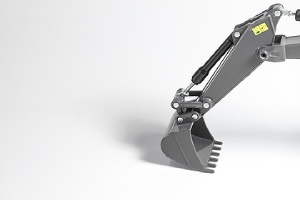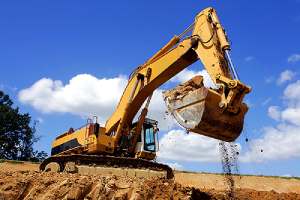 We have all seen backhoes before. They look like a tractor with a large digging arm attached to the back, although they can also use many other attachments. They are mostly considered the exclusive territory of professionals, but they are available for rent or even for purchase to anyone.
We have all seen backhoes before. They look like a tractor with a large digging arm attached to the back, although they can also use many other attachments. They are mostly considered the exclusive territory of professionals, but they are available for rent or even for purchase to anyone.
Backhoes can be an incredibly helpful tool for a lot of projects. Grading your lawn with a backhoe takes a fraction of the time compared to grading it by hand. This goes for any project that requires digging holes or trenches, or leveling an area. Even putting in a new fence goes more smoothly.
You can also use backhoes for tasks like uprooting old tree stumps or pushing dirt around. You would be surprised how often you need to simply push a big pile of dirt around when you are working on a major project. Here’s what you need to know about operating a backhoe if you are considering using one for your next big project.
Basic Controls
Left arm control
This level controls the boom, which is the first section of the backhoes rear arm, the one closest to the cab. Pull the lever towards you to lift the boom up, and push it away from you to lower it. Move it left and right to swing it side to side.
Right arm control
 This lever controls the stick, the second portion of the rear arm, and the bucket. Pull the lever towards you to bring the stick and bucket towards the cab, and push it away from you to move them away from the cab. Move the lever to the left to curl the bucket towards you for digging, and right to extend the bucket out for dumping.
This lever controls the stick, the second portion of the rear arm, and the bucket. Pull the lever towards you to bring the stick and bucket towards the cab, and push it away from you to move them away from the cab. Move the lever to the left to curl the bucket towards you for digging, and right to extend the bucket out for dumping.
Stabilizer controls
These are the smaller controls in between the left and right arm controls. The one on the left controls the left stabilizer, and the one on the right controls the right stabilizer. You can move each independently, which allows you to operate the backhoe on uneven ground.
How To Dig With A Backhoe
Clearance
Make sure you have plenty of room to the sides and rear of the backhoe to allow for full operation.
Use Stabilizers
You want to lower the stabilizers until the rear wheels are off the ground. Then lower the front bucket all the way down until the front wheels are also suspended.
Unlock The Boom
Raise the boom to its maximum height. Then, while pulling the left arm control toward you, step on the unlocking mechanism, which is usually a foot pedal on the right side of the cab.
Extend The Arm
Lower the boom and extend the stick and bucket at the same time for maximum reach. So, push both arm controls away from you at the same time.
Dig
 With the arm and bucket fully extended, move the right arm to the left to curl the bucket toward you.. How the control to the left until you feel the backhoe hit something solid. This means the bucket is full. Pull the right arm and left arm towards you to bring the stick in and raise the boom. Move the left arm control to the left or right to swing the full bucket to your dumping spot. Move the right arm control to the right to dump the bucket.
With the arm and bucket fully extended, move the right arm to the left to curl the bucket toward you.. How the control to the left until you feel the backhoe hit something solid. This means the bucket is full. Pull the right arm and left arm towards you to bring the stick in and raise the boom. Move the left arm control to the left or right to swing the full bucket to your dumping spot. Move the right arm control to the right to dump the bucket.
Repeat these steps as necessary until you have excavated all the dirt you needed to. If you need to backfill, you use the front bucket to push dirt back into the hole. Then, with the front bucket properly angled, you drive in reverse over the filled in hole to level it out.
Tips For Beginners
Keep The Dump Site Close
Do not place the dump site so far from the dig site that you have to turn the machine ninety degrees for each bucket load. Instead, aim for around twenty degrees. This gives you plenty of space to dig in but it saves you a surprising amount of time and fuel by not requiring nearly as much of a turn.
Shorten The Digging Distance
It is tempting to use the maximum reach every time you dig, but this greatly reduces the strength of the mechanism on each cycle. A shorter digging distance delivers much more power, and is more efficient.
It is easier to start the hole closer to the cab, and work your way away from it, than to start at a distance and work your way closer to the cab.
Watch Out For Utilities
A backhoe can easily rupture sewer, gas, and water lines, or snap power lines. Always know where the utilities are in relation to you and your backhoe.
Angle The Backhoe
It is almost impossible to see what you are doing if you are digging directly in front of the cab. Angle your backhoe slightly to the right or left so that you can always see what you are doing.
Warm Up
Once you have turned the backhoe on, let it warm up for a few minutes. This helps the hydraulic fluid circulate a little better. If you skip this step, there might be some hiccups in the operation initially. For an experienced operator this is not much of a problem, but for someone who is new to the use of a backhoe it might cause you to make more mistakes.
Go Slow
Most professionals say it takes a year or more of regular operation to feel comfortable using a backhoe. You will not have that much time with it, so it is best for your to go slow and be very careful when operating a backhoe. It is a big, expensive and potentially destructive piece of equipment. If things get out of hand, you can cause a lot of damage in a hurry.
As you can see, operating a backhoe is very complicated, and it can take a long time to truly feel comfortable using one. If you would like the benefits of a backhoe, but are not comfortable operating, contact the professionals at Dirt Connections. They have the experience to operate a backhoe smoothly and can help with dirt removal and delivery.











































